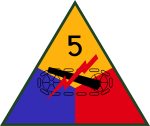5th Armored Division (United States)
| 5th Armored Division | |
|---|---|
|
5th Armored Division shoulder sleeve insignia | |
| Active |
1941–45 1950–56 |
| Country |
|
| Branch |
|
| Type | Armor |
| Role | Armored warfare |
| Size | Division |
| Nickname(s) | Victory[1] |
| Engagements | |
| Commanders | |
| Notable commanders | Lunsford E. Oliver |
| Insignia | |
| Distinctive Unit Insignia |
 |
| U.S. Armored Divisions | |
|---|---|
| Previous | Next |
| 4th Armored Division (Inactive) | 6th Armored Division (Inactive) |
The 5th Armored Division ("Victory"[1]) was an armored formation of the United States Army active from 1941 to 1945 and from 1950 to 1956.
History

The 5th Armored "Victory" Division was activated on 10 October 1941, and reached the United Kingdom in February 1944.
The division landed at Utah Beach on 24 July 1944 under the command of Major General Lunsford E. Oliver, and moved into combat on 2 August, driving south through Coutances, Avranches, and Vitré, and across the Mayenne River to seize the city of Le Mans, 8 August. Turning north, the division surrounded the Germans in Normandy by advancing, through Le Mêle-sur-Sarthe liberated on 11 August, to the edge of the city of Argentan on 12 August—8 days before the Argentan-Falaise Gap was closed.
Turning Argentan over to the 90th Infantry Division, the 5th Armored advanced 80 miles to capture the Eure River Line at Dreux on 16 August. Bitter fighting was encountered in clearing the Eure-Seine corridor, the second big trap in France. The 5th passed through Paris 30 August to spearhead V Corps drive through the Compiègne Forest, across the Oise, Aisne, and Somme Rivers, and reached the Belgian border at Condé, 2 September.
The division then turned east, advancing 100 miles in 8 hours, and crossed the Meuse at Charleville-Mézières, 4 September. Racing past Sedan, it liberated Luxembourg City on the 10th and deployed along the German border. The reconnaissance squadron of the division sent a patrol across the German border on the afternoon of 11 September to be the first of the Allies to cross the enemy frontier. On 14 September, the 5th penetrated the Siegfried Line at Wallendorf, remaining until the 20th, to draw off enemy reserves from Aachen.
In October it held defensive positions in the Monschau-Hofen sector. The division entered the Hurtgen Forest area in late November and pushed the enemy back to the banks of the Roer River in very heavy fighting. On 22 December it was withdrawn to Verviers and placed in 12th Army Group reserve.
Crossing the Roer on 25 February 1945 the 5th spearheaded the XIII Corps drive to the Rhine, crossing the Rhine at Wesel, 30 March. The Division reached the banks of the Elbe at Tangermunde, 12 April—45 miles from Berlin. On 16 April, the 5th moved to Klotze to wipe out the Von Clausewitz Panzer Division and again drove to the Elbe, this time in the vicinity of Dannenberg. The division mopped up in the Ninth Army sector until VE-day.
Structure
The division consisted of these units:
1941
- 5th Armored Brigade HHC
- 31st Armored Regiment (Light)
- 34th Armored Regiment (Light)
- 81st Armored Regiment (Medium)
- 65th Field Artillery Regiment (Armored)
- 58th Field Artillery Battalion (Armored)
- 85th Armored Reconnaissance Battalion
- 46th Infantry Regiment (Armored)
- Headquarters and Headquarters Company, 5th Armored Division
- 22d Engineer Battalion (Armored)
- 75th Medical Battalion (Armored)
- 145th Signal Company (Armored)
- 21st Ordnance Battalion (Armored)
- 19th Quartermaster Battalion (Armored)
1944–45
- 10th Tank Battalion
- 34th Tank Battalion
- 81st Tank Battalion
- 15th Armored Infantry Battalion
- 46th Armored Infantry Battalion
- 47th Armored Infantry Battalion
- HHB Division Artillery
- 47th Armored Field Artillery Battalion
- 71st Armored Field Artillery Battalion
- 95th Armored Field Artillery Battalion
- 85th Cavalry Reconnaissance Battalion, Mechanized
- 505th Counter Intelligence Corps Detachment
- Headquarters and Headquarters Company, 5th Armored Division
- HHC, Combat Command A
- HHC, Combat Command B
- Headquarters, Reserve Command
- HHC, Division Trains
- 75th Medical Battalion, Armored
- 127th Armored Maintenance Battalion
- Military Police Platoon
- 22d Armored Engineer Battalion
- 145th Armored Signal Battalion
- 628th Tank Destroyer Battalion (attached 2 August 1944 – 19 December 1944, 28 January 1945 – 9 May 1945)
- 629th Tank Destroyer Battalion (attached 29 August 1944 – 14 December 1944)
- 771st Tank Destroyer Battalion (attached 17 April 1945 – 24 April 1945)
- 387th AAA Automatic Weapons Battalion (attached 1 August 1944 – 25 March 1945, 28 March 1945 – 9 May 1945)
- 202d Field Artillery Battalion (attached 2 August 1944 – 25 August 1944)
The division's losses included 570 killed in action, 2,442 wounded in action, and 140 who died of wounds.
The division was inactivated on 11 October 1945, reactivated in 1950 at Fort Chaffee, AR, and inactivated for the final time in 1956.
Commanders
- MG Jack W. Heard (1941 - 1942)
- BG Sereno E. Brett (1942 - February 1943)
- MG Lunsford E. Oliver (February 1943 - May 1945)
References
- 1 2 "Special Unit Designations". United States Army Center of Military History. 21 April 2010. Archived from the original on 9 June 2010. Retrieved 23 June 2010.
Further reading
- Richard S. Gardner Paths of Armor, Battery Press, 4300 Dale Ave, Nashville TN 37204, 615-298-1401
External links
- Fact Sheet of the 5th Armored Division from http://www.battleofthebulge.org
- La libération de Quierzy
- The Road to Germany: The Story of the 5th Armored Division
